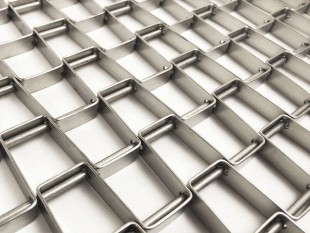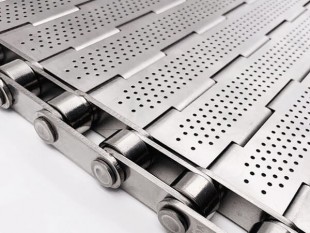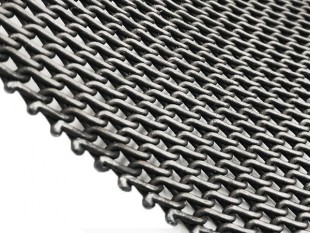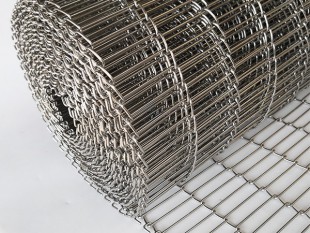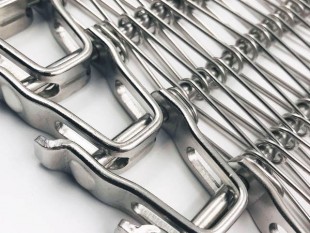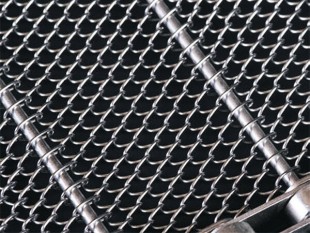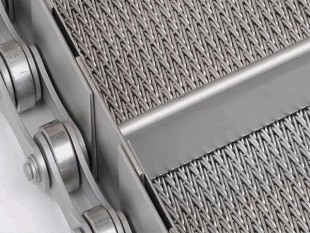Designed for harsh applications that require an
extremely heavy-duty belt, Eye Link Conveyor Belts are custom designed with
almost unlimited configurations to meet your applications demanding
requirements. The reliability and durability of the belts are the main reason
for its success, combined with the various ranges of belt materials and the
sophisticated design, which makes it relatively simple to make variant types of
belts.


Eye Link Conveyor Belts are available with multiple drive options
including friction driven cage rollers, positive drive sprockets, and an
optional chain edge drive for enhanced tracking and reliability. Besides, side
guard plates and cross flights are available on request. Side plates is
designed to control the height of the product to be conveyed.


Features of eye link conveyor belts
• Single level surface products parts will not get
entrapped between several layers of the belt
• Flat conveying surface, open mesh configuration,
and ease of cleaning
• Completely customizable with features including
side guards, chain drive, and flights
• High-temperature capability and a wide variety of
steel specifications available
• Smooth and single-level surface without product
entrapment
• Toughest conveyor belt available
• Excellent air and fluid drainage
• High strength and excellent carrying ability
• Flat surface profile
• Modular design


Belt Types
Eye Link Conveyor Belts has a standard construction based on a straight modular form. It is designed and built without spacers or perpendicularly welded under wires. This allows excellent flow-through in applications where no cross-support is required. Eye Link Conveyor Belts without spacers is also easily repaired with minimal cost.
Eye link conveyor belts — Available in six types that have their own specific advantages.
From eye link belts with pressed eye links to create the smallest opening possible to eyelink belts with springs to guarantee good shock resistance and resistance to lateral forces — PFM Screen has many types of eyelink belts that each have their own specific advantages.

Full eye links
On a full eye link belt the eyelinks lie against each other, and the opening is equal to the wire diameter. It is designed and built without spacers or perpendicularly welded under wires. This allows excellent flow-through in applications where no cross-support is required. The belt is often used in food processing for its flat conveying surface, open mesh configuration, and ease of cleaning. This type eye Link Conveyor Belt without spacers is also easily repaired with minimal cost.

Pressed eye links
Some applications require the smallest opening possible. By flattening the eyes of the eye links the opening between the links becomes smaller. This type is very appropriate for small and fine-structured products.

Welded eye links
The eye links are welded on to an location wire, so that a module is created. Very narrow and very wide openings can be created, depending on the processing of the products concerned.The underwelded wire eliminates the potential bacteria traps under the spacers, springs, rings, and sleeves. This configuration makes cleaning and sanitation easy and more efficient.

Pressed and welded eye links
Some applications require a stable belt in combination with a small opening/drain. The accuracy of our welding process allows us to produce modules with very small intervals between the eye links. The modular structure makes the assembly of very broad belts possible.

Eye links with springs
Springs help create a more dimensionally stable belt in heating or freezing applications. These belts are more dimensionally stable because the wires are able to move on the cross rod. Springs also expose a large proportion of the connecting rod for improved cleaning and sanitizing. The placement of springs between the eye links ensures that they are positioned at regular intervals. The result is a relatively light belt with specific qualities, such as a good shock resistance and resistance to lateral forces.

Eye links with bushings or washers
This versatile variation of eye link belt uses
bushings or washers between the wires to increase the belt gap. By increasing
the belt gap, more air will circulate around the bottom of the product.
Increasing the product exposure to this additional air flow improves the
efficiency of your process. When bushings or washers are added the belts become
heavier and more rigid.
Edge Availability

Eye Link Belt with Welded edge
At both sides the belt is fitted with plate links, and the far ends of the cross rods are fitted with washers and subsequently welded. This results in a thorough finishing of the belt in combination with the desired bearing surface.

Eye Link Belt with Reinforcing Plates
Reinforcing plates are the typical edge style. These are solid metal plates added before the connecting rod is welded. The belt edges are generally formed by two ore more rows of plate links. The wire links and plate links are assembled on the cross rod which is fitted on both sides with a welded ring or a butted head. Additional reinforcing plates can be added at the edge of the belt, or at specified increments across the belt width to further enhance the strength of this belt.

Eye Link Belt with Chain Edge
The belt edges are formed by a hollow pin chain. The links and chains are assembled on the cross rod which is fitted on both sides with a welded ring. The chain is mostly kept in place by welding a ring to the outside as well as to the inside of the chain. If the ends of the cross rods are narrowed, the inside of the chain is secured by this narrowing and the inner ring is cancelled. Chain edges on Eye link belts as an alternative method for driving the belt for enhanced tracking and reliability.

Eye Link Belt with side Guards
Eye Link belts can be equipped with side guards to prevent product from falling off the side of the belt. Height and shape of the side guards can be customized for your product or application. These side guards can also be inserted at various points across the belt width providing a positive separation between rows of product.
Material Availability
304 & 316 stainless steel, Carbon steel, other materials available upon request
|
Material
|
Maximum Wire Operating Temperature °C
|
|
Carbon Steel
|
550
|
|
304 Stainless Steel
|
750
|
|
316 Stainless Steel
|
800
|
|
316L Stainless Steel
|
800
|
Specifications

A: Gap Width (mm) B: Pitch (mm)
C: Cross Rod Dia (mm) D: Underside Welded Wire Dia (mm)
E: Wire Link Dia (mm) F: Reinforcing Plate (mm)
G: Overall Belt Width (mm)
Eye link conveyor belt without spacers
|
Eye link conveyor belt without spacers
|
|
Item No.
|
Belt Pitch (mm)
|
Wire Dia. (mm)
|
Cross Rod Dia. (mm)
|
Belt Pitch (mm)
|
Wire Dia. (mm)
|
Cross Rod Dia. (mm)
|
|
ELCB01
|
15.875
|
1.8
|
3.2
|
50
|
3
|
5
|
|
ELCB02
|
25
|
2
|
5
|
50.8
|
1.6
|
8
|
|
ELCB03
|
25.4
|
2
|
5
|
50.8
|
1.6
|
6
|
|
ELCB04
|
30
|
1.6
|
4
|
50.8
|
2
|
8
|
|
ELCB05
|
30
|
2
|
4
|
50.8
|
2.5
|
8
|
|
ELCB06
|
30
|
2
|
5
|
50.8
|
2.5
|
5
|
|
ELCB07
|
30
|
2
|
7
|
50.8
|
3
|
5
|
|
ELCB08
|
30
|
2
|
8
|
50.8
|
4
|
7
|
|
ELCB09
|
31.75
|
2
|
5
|
60
|
2
|
5
|
|
ELCB10
|
50
|
1.4
|
5
|
60
|
2.5
|
5
|
|
ELCB11
|
50
|
1.6
|
5
|
70
|
4
|
7
|
|
ELCB12
|
50
|
2
|
5
|
75
|
2.5
|
5
|
|
ELCB13
|
50
|
2.5
|
6
|
75
|
2.5
|
8
|
|
ELCB14
|
50
|
2.5
|
8
|
100
|
3
|
8
|
|
Eye link conveyor belt with under welded wire
spacing
|
|
Item No.
|
Belt Pitch
(mm)
|
Wire Diameter
(mm)
|
Cross Rod Diameter
(mm)
|
Minimum Gap Spacing
(mm)
|
Gap in Steps of
(mm)
|
Maximum No. of Welded Wires
(mm)
|
|
ECBWS01
|
15.875
|
1.8
|
3.2
|
2
|
0.1
|
1
|
|
ECBWS02
|
25
|
2
|
5
|
2.3
|
0.1
|
2
|
|
ECBWS03
|
25.4
|
2
|
5
|
2.3
|
0.1
|
2
|
|
ECBWS04
|
30
|
2
|
4
|
2.3
|
0.1
|
2
|
|
ECBWS05
|
30
|
2
|
5
|
2.3
|
0.1
|
2
|
|
ECBWS06
|
50
|
2
|
5
|
2.3
|
0.1
|
3
|
|
ECBWS07
|
50
|
2.5
|
5
|
2.8
|
0.1
|
3
|
|
ECBWS08
|
50
|
2.5
|
6
|
2.8
|
0.1
|
3
|
|
ECBWS09
|
50.8
|
2.5
|
8
|
2.8
|
0.1
|
3
|
|
ECBWS10
|
50.8
|
3
|
8
|
3.3
|
0.1
|
3
|
|
ECBWS11
|
75
|
2.5
|
5
|
2.8
|
0.1
|
3
|
|
ECBWS12
|
75
|
2.5
|
8
|
2.8
|
0.1
|
3
|
|
Eye link conveyor belt with springs as spacers
|
|
Item No.
|
Belt Pitch
(mm)
|
Wire Diameter
(mm)
|
Cross Rod Diameter
(mm)
|
Minimum Gap Spacing
(mm)
|
Gap Spacing also Available in these Widths
(mm)
|
|
ECBWS01
|
25
|
2
|
5
|
7
|
8
|
10
|
12
|
15
|
17.5
|
20
|
|
ECBWS02
|
25.4
|
2
|
5
|
7
|
8
|
10
|
12
|
15
|
17.5
|
20
|
|
ECBWS03
|
30
|
2
|
4
|
7
|
8
|
10
|
12
|
-
|
-
|
20
|
|
ECBWS04
|
30
|
2
|
5
|
7
|
8
|
10
|
12
|
15
|
17.5
|
20
|
|
ECBWS05
|
31.75
|
2
|
5
|
7
|
8
|
10
|
12
|
15
|
17.5
|
20
|
|
ECBWS06
|
50
|
2
|
5
|
7
|
8
|
10
|
12
|
15
|
17.5
|
20
|
|
ECBWS07
|
50
|
2.5
|
5
|
7.5
|
8
|
10
|
12
|
15
|
17.5
|
20
|
|
ECBWS08
|
50
|
2.5
|
6
|
7.5
|
-
|
-
|
-
|
-
|
-
|
20
|
|
ECBWS09
|
50
|
3
|
8
|
10.5
|
-
|
-
|
-
|
15.5
|
-
|
20
|
|
ECBWS10
|
50.8
|
2
|
6
|
7
|
-
|
-
|
-
|
-
|
-
|
-
|
|
ECBWS11
|
50.8
|
2
|
8
|
8
|
-
|
-
|
-
|
-
|
-
|
-
|
|
ECBWS12
|
50.8
|
2.5
|
6
|
7.5
|
-
|
-
|
-
|
-
|
-
|
20
|
|
ECBWS13
|
50.8
|
2.5
|
8
|
10
|
-
|
-
|
-
|
15
|
-
|
20
|
|
ECBWS14
|
50.8
|
3
|
8
|
10.5
|
-
|
-
|
-
|
15.5
|
-
|
20
|
|
ECBWS15
|
50.8
|
4
|
8
|
12
|
-
|
-
|
-
|
-
|
-
|
-
|
|
ECBWS16
|
60
|
2.5
|
5
|
7
|
8
|
10
|
12
|
15
|
17.5
|
20
|
|
ECBWS17
|
60
|
2.5
|
5
|
7.5
|
8.5
|
10
|
12
|
15
|
17.5
|
20
|
|
ECBWS18
|
70
|
4
|
7
|
12
|
-
|
-
|
-
|
-
|
-
|
-
|
|
ECBWS19
|
75
|
2.5
|
5
|
7.5
|
8.5
|
10
|
12
|
15
|
17.5
|
20
|
|
ECBWS20
|
75
|
2.5
|
8
|
10
|
-
|
10
|
-
|
15
|
-
|
20
|
|
ECBWS21
|
100
|
3
|
8
|
10.5
|
-
|
10.5
|
-
|
15.5
|
-
|
20
|
|
Eye link conveyor belt with rings as spacers
|
|
Item No.
|
Belt Pitch
(mm)
|
Wire Diameter
(mm)
|
Cross Rod Diameter
(mm)
|
Minimum Gap Spacing
(mm)
|
Gap Spacing can be increased by
(mm)
|
|
ECBWR01
|
|
|
|
|
|
|
ECBWR02
|
25
|
2
|
5
|
4
|
2
|
|
ECBWR03
|
25.4
|
2
|
5
|
4
|
2
|
|
ECBWR04
|
30
|
2
|
4
|
4
|
2
|
|
ECBWR05
|
30
|
2
|
5
|
4
|
2
|
|
ECBWR06
|
31.75
|
2
|
5
|
4
|
2
|
|
ECBWR07
|
50
|
2
|
5
|
4
|
2
|
|
ECBWR08
|
50
|
2.5
|
5
|
5
|
2.5
|
|
ECBWR09
|
50
|
2.5
|
6
|
5
|
2.5
|
|
ECBWR10
|
50.8
|
2.5
|
6
|
5
|
2.5
|
|
ECBWR11
|
50.8
|
2.5
|
8
|
5
|
2.5
|
|
ECBWR12
|
50.8
|
4
|
8
|
8
|
4
|
|
ECBWR13
|
60
|
2
|
5
|
4
|
2
|
|
ECBWR14
|
60
|
2.5
|
5
|
5
|
2.5
|
|
ECBWR15
|
75
|
2.5
|
5
|
5
|
2.5
|
|
ECBWR16
|
75
|
2.5
|
8
|
5
|
2.5
|
 +86-15369679157
+86-15369679157






















